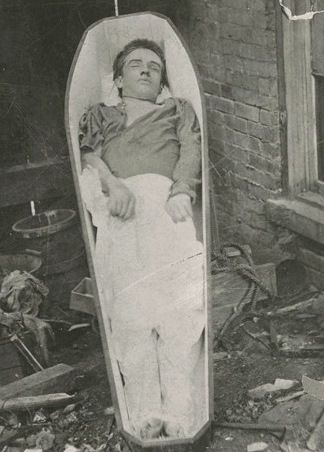
|
Photo of the Month |
|
|
LYNCHED! The lives of convicted horse thief Charles Pierce and deputy sheriff Henry B. "Teddy" Frank of Bloomington, IL collided and ended savagely on the evening of Oct. 1, 1881.
The son of Jacob and Catharine (Weyand) Frank of Somerset, PA and Bloomington, Henry one of four brothers who had served in the Civil War. At the time of his murder, he worked as McLean County jailkeeper and was considered a "well-known, well-liked and respected public servant," said the loomington Pantagraph. On the fateful day, he was directed to escort Pierce from the courtroom to his jail cell. As they walked, Pierce grabbed Teddy's .44 Smith & Wesson pistol and fired. His first shot hit Henry in the shoulder; the second struck directly in the chest, killing him instantly. Pierce quickly was apprehended and placed in his cell.
Word swept through the town, and a mob of outraged citizens formed within the hour, calling for frontier justice. A number of public officials, including future Illinois Governor Joseph W. Fifer, tried to calm the mob. But the townspeople would not be assuaged and continued to grow to several thousand in number. At some point they used telegraph poles to batter down the doors of the prison and then haul Pierce outside. Even though he asked for time to pray, a three-quarter inch thick rope was wrapped around the prisoner's neck, and he was struck up on a tree limb across the street. One spectator climbed the tree and pulled the noose even higher, and then dropped it again, to amplify the suffocation process.
A Chicago newspaper reported that as he gasped for breath, Pierce was "subjected to the grossest insult not becoming the most brutal savage. The pants were ripped from the body, and a lighted cigar stuck in the gaping mouth. One plug-ugly, more atrocious than the rest, slid down the rope with great force to the shoulders of the struggling victim. Small boys hooted, yelled, and taunted [Pierce], calling him all manner of vile names." It was "the county's only documented lynching" in its history, said the Pantagraph.
The corpse was cut down and then displayed in the windows of the local funeral parlor for hundreds to see, and a photograph was taken. A scanned copy of the image graciously has been provided to Minerd.com by the McLean County History Museum.
|
|
|
Copyright © 2019 Mark A. Miner. |

